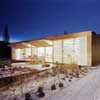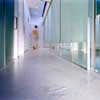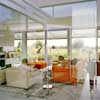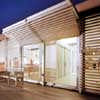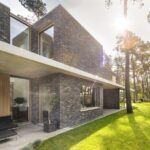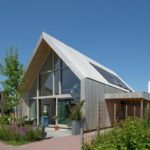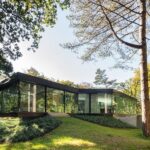Villa Deys, Rhenen Residence, Dutch Home Photos, NL Design Property Images
Villa Deys Holland : Rhenen House
Rhenen Residential Development, The Netherlands design by Architectenbureau Paul de Ruiter
20 Feb 2009
Villa Deys
Rhenen residence
Design: Architectenbureau Paul de Ruiter
Case: Villa Deys
Paul de Ruiter always wanted to build a villa in what he considers one of the most attractive locations in the Netherlands, on the outskirts of Rhenen, in the Rhine water meadows. This would be a villa to which he could apply his own design philosophy: innovative design. His goal was not to be directed by what already exists, but to develop his own solutions that would make it possible to implement the ideal design.
Therefore in 1994, as an architect at the start of his career, he took the unusual decision to take matters into his own hands and create his own working assignment. He took out an option on a plot of land, which was in use at that time for market gardening, and became the developer of this site himself. Not just one, but four villas were constructed on this site; all four of which reflect the character of their residents.
ONE SIGNATURE
In all the four villas, special attention was paid to the use of daylight, natural materials and the surrounding landscape.
Villa HJ is characterised by its patio and the livingroom at the first floor, which makes it possible to enjoy the superb view while maximum privacy is guaranteed. In Villa Room, the living areas, an artist’s studio and an exhibition area are combined in the central feature of the house, the atrium, which acts as a light well and allows the northernlight to penetrate deeply into the house.
Villa Truyens has a ‘floating’ upper floor, offering the best possible view of the water meadows. Villa Deys a villa that can be adapted over time to the age of the residents, by making use of technological innovations and each space opening smoothly into the next one.
VILLA DEYS
The senior couple Mr and Mrs Deys bought the first of the four building plots in the Schoutenboomgaardweg in Rhenen. This purchase included a sketch design for the villa by Paul de Ruiter. The main criterion for the design was the wishes of the customers. It also had to satisfy the stringent requirements imposed by Paul de Ruiter himself that the house must merge into the landscape and should preferably have a grass roof.
The clients primarily wanted a practical home where they could go on living until an advanced age. And because both wanted to keep fit and love swimming, integrating a swimming pool into the design was an important wish. All the above is fulfilled in a villa that can be adapted over time to the age of the residents.
The living functions of Villa Deys are placed around the swimming pool and spaciously blend into each other. The house is completely integrated into the landscape. If you look down from the Cunera hill just behind the house, all you see is the sedum roof, the front façades of gabions and the side façades, which are covered completely with slats. It strongly resembles the many farm outbuildings that can be seen in the area.
INTELLIGENT USE OF SPACE
Paul de Ruiter divided the house into three strips. The southern strip contains the living room, kitchen and workroom, while the northern strip houses the bedrooms and the garage. The middle strip consists of the swimming pool with portals on each side, which act as entrance and as conservatory. The strips are offset in relation to each other, yielding the largest possible outer wall surface so that the admission of daylight is maximised.
Light is the key concept in the design of Villa Deys and it is not just the large outer wall surface that contributes to the maximized admission of daylight. The entire southern façade is made of glass. The roof of the swimming pool strip –which also incorporates several skylights – is lower-lying than the adjoining roof surfaces, and the difference in height is inset with glass, thus allowing plenty of light to enter the house.
The swimming pool acts as a light well in the middle of the house and the light-coloured floor of synthetic material, white plastered walls and ceilings and the water and the glass walls of the swimming pool reflect the light optimally and ensure that it penetrates deep into the house.
ELECTRICAL
The entire house was designed to satisfy the wishes of the owners. Everything is on the ground floor, without thresholds and with sliding doors. Almost everything can be operated electrically, to ensure that the residents can continue living in the house even when they grow old and infirm: lighting, curtains, the wooden exterior sun blinds and the front door. The large garage that is situated in one section of the building could be converted into accommodation for nursing staff if necessary.
In spite of the extensive level of automation in the house, the mass of technology present is barely noticeable. This is possible because the technology is primarily located in the basement, in the floors and in the ceilings.
MIDPOINT
The swimming pool is literally and figuratively the heart of the house. The water surface is at the same height of the surrounding floors and surrounded by glass, it forms the middle of the three strips that make up the villa. The glass used around the swimming pool is partially sand-blasted. Only a 50 cm high strip at floor height is transparent. As a result, a swimmer in the pool can see into the living room, without being visible himself.
The fact that the swimming pool is surrounded by glass not only has an aesthetic effect, it also prevents moisture problems in the rest of the house. Dark tiles, a glass overflow rim and a stainless steel drain ensure that the swimming pool does not overly dominate the house.
CLIMATE SYSTEM
The water in the pool has a constant temperature of 27°C, which of course uses energy and costs money. However, by linking the pool heating system with the low-temperature heating system of the house, in combination with a water pump, the pool area re-emits the energy it has absorbed and becomes part of the energy-saving climate system in the house. The swimming pool therefore helps to achieve the maximum yield from the energy available.
FAÇADE TECHNOLOGY
The entire length of the southern façade consists of sliding doors of glass and aluminium, giving the residents a breathtaking view over the river and the water meadows, and at the same time allowing the sun free entry. To keep out excessive heat and sunlight, a sunblind was developed consisting of 10 panels with horizontal wooden slats, made of western red cedar to blend in with the farm outbuildings that are scattered in the surrounding landscape.
To adjust the sunblind, the panels as a whole are moved, rather than the individual slats. Each of the 10 panels consists of two sections with a horizontal join in the middle. When they are opened, either manually or by electronic programming, the panel is lifted to form a porch above the glass door. When the panels are closed, they fall into a lock at the bottom. This makes it possible to keep the sliding doors open without the risk of burglary.
ATTRACTIVE AESTHETICS
Villa Deys contains a large amount of technology, is modern and full of detailed design elements, but is at the same time fully integrated into its surroundings. For example, the ground level is lowered on the west side, so that the living strips ‘float’ above the water of the pond that has been constructed here. The floating roof construction, which is necessary because most of the walls are of glass, reinforces the attractive, modern appearance of the house. Villa Deys proves that aesthetics, sustainability, energy efficiency and ease of use can very well go hand in hand.
ARCHITECTURE AND AGE
Although Villa Deys is a house for senior citizens, there is nothing in the outward appearance of the villa that indicates this. Architecture can cater in many ways to the wishes and the infirmities of people who are growing older, without sacrificing modernity and appearance. Villa Deys is all on one floor without tresholds and almost completely electronically operatable, but it is not that which makes the villa such a pleasure to live in. Daylight plays a particularly important role here, but it is often the details that improve the ease and comfort of a house for the elderly.
Take for example the deterioration in vision and the ability to distinguish colours that often goes with advancing age. A completely white bathroom can cause great problems, because there are no orientation points and no contrasts. This can make elderly people lose confidence and it increases the risk of falling. The simple use of different colours in a bathroom can make a great deal of difference.
PRODUCT DEVELOPMENT: BOIL
Paul de Ruiter’s architectural bureau regularly develops new products, often in connection with design commissions. If a building product is needed that is not available on the market, such as the shutters for Villa Deys, research & development takes place followed by product development. When a new product is developed in-house and then put on the market, a demand for that product is often generated.
BOIL came into existence as a result of this demand and offers the possibility of sharing products and ideas with other architects. BOIL is a company that markets the intellectual ownership of the product. The returns are used to finance the new developments. For more information, see www.boil.nl.
COMMISSIONING A BUILDING
In 2002 Villa Deys won two prizes. ‘The Dedalo Minosse International Prize for commissioning a building’ and the ‘European Architecture Award Luigi Cosenza 2002’. The Dedalo Minosse prize is a prize intended as a joint prize for the customer and the architect, as they have created a valuable building by working together.
As particular consideration was given to facilities for coping with old age and invalidity during the construction of Villa Deys, it received the Special Award, in collaboration with the Italian Institute of Design and Disability.
The ‘European Architecture Award Luigi Cosenza’ is a prize to promote young European architects and their extraordinary buildings.
Villa Deys – Building Information
Name: Villa Deys, Rhenen
Address: Schoutenboomgaardweg 1e, 3911 AG Rhenen
Gross floor area: 344 m²
Volume: 1.290 m³
Program: Villa suitable for elderly people, equipped with applications such as domotics
Start design: 1999
Start building: Jan 2001
Completion: May 2002
Design team
Client: Mr and Mrs Deys
Developer: Architectural office Paul de Ruiter bv
Design: Architectural office Paul de Ruiter bv
Project architect: Paul de Ruiter
Project team: Michael Noordam, Sander van Veen, Dieter Blok, Lei Coppus, Hannes Ochmann, Mathilde Joosse, Willeke Smit, Monique Verhoef, Björn Peters
Advice installations: Halmos bv
Milieukundig onderzoek- en ontwerpbureau BOOM
Lighting advice: Van Dijk en Partners
Interior architect: Architectural office Paul de Ruiter bv
Landscape ecology: Buro Zijaanzicht
Landscape design: Sytze Hager
Photographs: Rien van Rijthoven
Villa Deys images / information from Architectenbureau Paul de Ruiter 200209
Architectenbureau Paul de Ruiter
Location: Schoutenboomgaardweg 1e, 3911 AG Rhenen, Netherlands, northern Europe
Architecture in The Netherlands
Contemporary Dutch Architecture
Netherlands Architecture Designs – chronological list
Amsterdam Architecture Walking Tours by e-architect
Dutch Architect – design firm listings
Buildings in the area
Buildings by Architectenbureau Paul de Ruiter
Comments / photos for the Villa Deys Holland Architecture page welcome:

